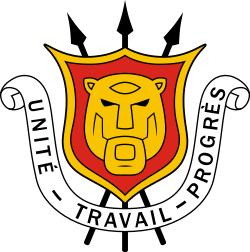History of the office
Transitional period (2001–2005)
A new transitional power-sharing government took office on 1 November 2001. Interim president Pierre Buyoya became transitional president for a period of 18 months. At the end of his term in 2003, Hutu vice-president Domitien Ndayizeye took office and appointed a Tutsi (Alphonse-Marie Kadege) as vice-president. In November 2004, Kadege was sacked as vice-president and replaced by Frédéric Ngenzebuhoro. Although Ndayizeye's term was due to end in late 2004 following elections, the transitional period was extended and planned elections were delayed. Elections were held in mid-2005 and the transitional period is due to end on 26 August 2005, when the newly elected president takes office.
Vice-presidency 2005–2018
Burundi's new constitution, approved in a 28 February 2005 constitutional referendum, calls for a two-member vice-presidency (similar to that of the interim period). The 1st vice-president will be responsible for political and administrative affairs, while the 2nd vice-president will handle social and economic affairs. One vice-president will be an ethnic Hutu and the other a Tutsi. Nominees must be approved by both chambers of parliament in order to take office.
On 29 August 2005, President Pierre Nkurunziza nominated Martin Nduwimana and Alice Nzomukunda for the posts of 1st and 2nd vice-president. Both received approval from parliament and were immediately sworn in. Nzomukunda resigned on 5 September 2006. [1] She was replaced by Marina Barampama two days later.
In February 2007, Barampama was replaced by Gabriel Ntisezerana. In November 2007, Nduwimana was replaced by Yves Sahinguvu.
In August 2010, Sahinguvu was replaced by Therence Sinunguruza and Ntisezerana was replaced by Gervais Rufyikiri.
Vice-presidency since 2018
New constitutional amendments were approved in a 17 May 2018 constitutional referendum. The post of second vice-president will be abolished. The remaining vice-president, who will have limited powers, will be selected from a political party and ethnic group that differs from those of the president. [2]
This page is based on this
Wikipedia article Text is available under the
CC BY-SA 4.0 license; additional terms may apply.
Images, videos and audio are available under their respective licenses.







